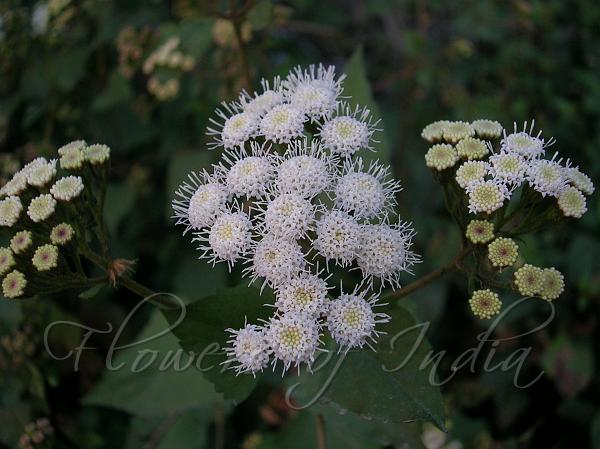|
| Catweed |
|

|

| File size | 673011 |
| Original date | 2/27/06 10:00 AM |
| Resolution | 2048 x 1536 |
| Flash | Flash did not fire, auto |
| Focal length | 8.0mm |
| Exposure time | 1/133s |
| Aperture | 3.2 |
| Focus Distance | |
| Metering Mode | Partial |
| Camera make | NIKON |
| Camera model | E3700 |
| Sensor type |
|
|
|
|
Photo: |
Botanical name: Ageratina adenophora Family: Asteraceae (Sunflower family)
Synonyms: Eupatorium adenophorum, Eupatorium glandulosum
Synonyms: Eupatorium adenophorum, Eupatorium glandulosum
Native to Central America, Catweed is an erect, bushy, leafy, many-stemmed
herb, growing to 2 m tall. It commonly occurs in disturbed areas. Leaves
are opposite, soft, thin, shaped like a triangle or rhombus, with a toothed
edge and conspicuous veins. They are dark green on the upper surface,
lighter underneath, and may be slightly hairy; 4-12cm long, 3-9cm wide.
Flowers profusely in spring and summer, producing dense clusters of white
sticky hairy flowers, 5-8 mm in diameter, at the ends of the branchlets.
Seed production is enormous - 10,000 to 100,000 per year when mature. The
seeds are very small, light, brown to black, with a 4mm 'parachute' of
white hairs, mid to late spring. Germination rates are high. Catweed has become
widely naturalized in NE India.
Medicinal uses: The plant possesses significant wound
healing properties according to the traditional use of this plant,
and has been confirmed by modern studies. The curious Manipuri name
Japan napi/opro owed its origin to the wound healing uses of this
plant by Japanese army during the Second World War. It is said by local
healers, that the Japanese Army during their conquest, dispersed seeds of
this plant wherever they tread, which have spread freely to this day.
The plant possesses significant wound
healing properties according to the traditional use of this plant,
and has been confirmed by modern studies. The curious Manipuri name
Japan napi/opro owed its origin to the wound healing uses of this
plant by Japanese army during the Second World War. It is said by local
healers, that the Japanese Army during their conquest, dispersed seeds of
this plant wherever they tread, which have spread freely to this day.
Medicinal uses:
 The plant possesses significant wound
healing properties according to the traditional use of this plant,
and has been confirmed by modern studies. The curious Manipuri name
Japan napi/opro owed its origin to the wound healing uses of this
plant by Japanese army during the Second World War. It is said by local
healers, that the Japanese Army during their conquest, dispersed seeds of
this plant wherever they tread, which have spread freely to this day.
The plant possesses significant wound
healing properties according to the traditional use of this plant,
and has been confirmed by modern studies. The curious Manipuri name
Japan napi/opro owed its origin to the wound healing uses of this
plant by Japanese army during the Second World War. It is said by local
healers, that the Japanese Army during their conquest, dispersed seeds of
this plant wherever they tread, which have spread freely to this day.| Identification credit: Tony from Sydney, Nidhan Singh | Photographed at Mussoorie, Uttarakhand, Imphal, Manipur & Sirmaur distt, Himachal Pradesh. |
• Is this flower misidentified? If yes,